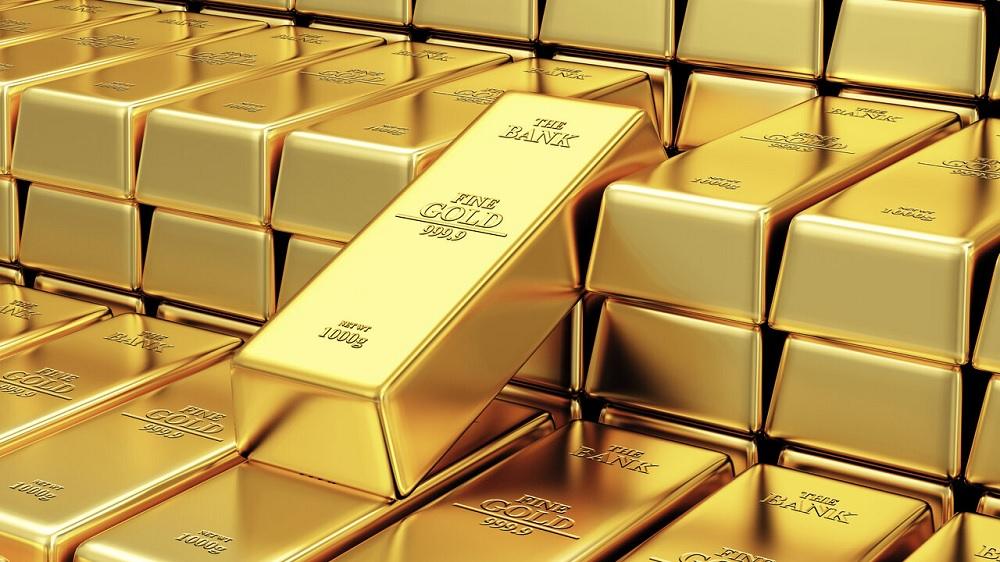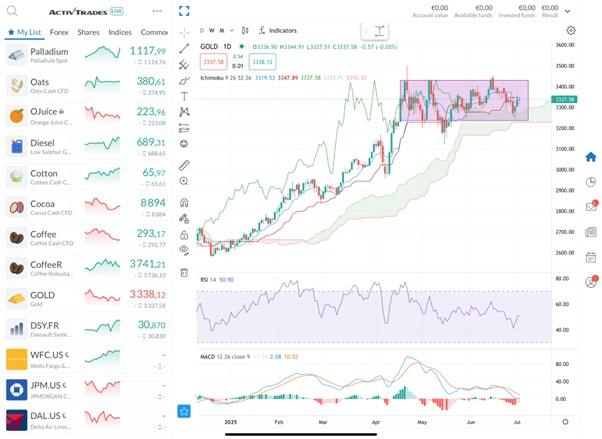
The following is a version of Carolane De Palmas, a shopping analyzer at Retail FX and CFDS Broker Activetrades.
Gold It has delivered a separate performance in the first half of 2025, recording the strongest medium year of the rally since 2007. According to Activtrades, precious metal has increased over 25% on an annual basis, currently negotiating to $ 3,337. The race was largely fueled by a series of record in April, when gold prices summarized $ 3,499 a ounce, setting a new top of all time.
As mentioned by Wall Street Journal magazineThis marks the best six -month gold rendering in almost two decades, even surpassing the post -funding economic crisis in early 2010. In the second quarter ended June 30, Gold managed to earn more than 5.5%, covering up to seven months and seven months of prices – a great extent.

Gold Chart – Source: Activtrades
A look at the daily chart on the Activtrader platform shows that gold has entered a period of integration since it culminates in late April. The merchandise has negotiated laterally, limited to a range defined by a resistance zone close to $ 3,431 and supports about $ 3,240. Technically, the relative endurance index (RSI) ranges close to the neutral level 50 after gradual reduction from the top, indicating a temporary pause in the direction of the momentum as markets digest recent profits.
While gold remains steadily supported by long -term factors, the current price action suggests that traders expect new catalysts to determine the next part. In the following sections, we will explore what is behind the explosive rise of Gold so far this year, the macroeconomic forces in the game and if the yellow metal still has room to run in the second half of 2025.
What will follow for gold? Weighing the rise against prolonged uncertainty
While Gold continues to benefit from a strong base of long -term swelling drivers, his short -term orbit remains less clear. After a strong increase in the first half of 2025, many market participants appear to be waiting for a new catalyst before promoting prices significantly higher.
Analysts at DimsA Fitch solutions unit suggests that gold rally may lose steam – at least temporarily. They also argue that the precious metal remains well supported, thanks to the combination of continuing geopolitical tensions, the uncertainty about world trade, the market for central bank and a persistently weak US dollar.
The recent escalation between Israel and Iran provided yet another reminder of the value of gold as geopolitical hedge. In times of international conflict or political instability, investors tend to seek the security and neutrality offered by gold. This is part of a broader trend in which traditional monetary guides-such as the actual interest rates and the expectations of inflation-are exiled by non-financial forces.
From 2008 to the beginning of 2022, gold typically moved vice versa in real returns, acting as a compensation for low interest rates or increasing inflation. But from Russia’s invasion of Ukraine, this relationship is significantly weakening. Gold has continued to grow even when real yields remain increased, suggesting that the new dynamic is now affecting the market.
Today, factors such as the differentiation of reserves from central banks, efforts to avoid dollars and growing geopolitical tensions have taken the focus. For many countries – especially in the emerging world – gold is no longer just an inflation compensation, but a strategic warehouse of value. The lack of risk of the counterparty and political neutrality make it particularly attractive at a time when funding itself is increasingly used as a geopolitical tool.
Another important guide to Gold’s recent power was the offensive market of the central bank.
In 2024, central banks bought over 1,000 tonnes of gold, twice the average of the previous decade, lifting the world official reserve to a record of 36,000 tonnes. This market has gathered in emerging economies such as China, Turkey and India, which have added more than 600 tonnes from the end of 2021. These nations clearly seek to reduce their dependence on reserves such as the US dollar and are turning gold.
Nevertheless, breaking the previous high record would still require a significant catalyst. According to the BMI, a significant escalation in the Middle Eastern conflict or a large, unexpected reduction in interest rates by the US Federal Bank would probably be necessary to drive prices significantly higher. However, the Fed remained careful. President Jerome Powell recently suggested that interest rates could have already been reduced if it was not for the fiscal and political volatility introduced by President Trump’s administration.
For the time being, the BMI maintains the average prediction of gold prices 2025 at $ 3,100 per ounce, below current levels.
Meanwhile, investors shift part of their focus to silver, which has grown with gold, but also benefits from the strong profile of industrial demand. In June 2025, silver prices hit the highest level since 2011, rising to about $ 37.29 per ounce, marking a 25% profit on a year. This is followed by a powerful 2024, during which prices increased on average 21%. Unlike gold, the value of Silver is closely linked to its use in electronic, renewable energy sources and chip tension technologies, areas developed due to demand related to AI and green infrastructure investment.
According to the latter Worldwide SilverIndustrial demand for silver increased for the fourth consecutive year in 2024, reaching 680.5 million ounces, an annual increase of 4%. Much of this growth is due to the solar sector, where China’s aggressive expansion to solar cell production has sharply increased the use of silver.
As we move in the second half of 2025, gold remains well positioned thanks to persistent macroeconomic and geopolitical uncertainties. But without a clear short -term catalyst, its next movement may depend more on external disorders on the constant momentum. Silver, on the other hand, could continue to overcome whether industrial demand remains strong, offering investors an interesting supplement to the traditional exhibition of precious metals.
The information provided does not constitute investment research. The material has not been prepared in accordance with the legal requirements aimed at promoting the independence of investment research and therefore must be regarded as marketing communication.
All information has been prepared by Activtrades (“AT”). The information does not contain a record of AT prices or an offer or attraction for a transaction in any financial instrument. No representation or guarantee of the accuracy or completeness of this information is given.
Any material provided does not take into account the specific investment target and the financial situation of any person who may receive it. The previous performance is not a reliable indicator of future performance. AT provides a service only for execution. Consequently, every person acting for the information provided does so at his own responsibility. Forecasts are not guarantees. Adjustable status does not guarantee security.

